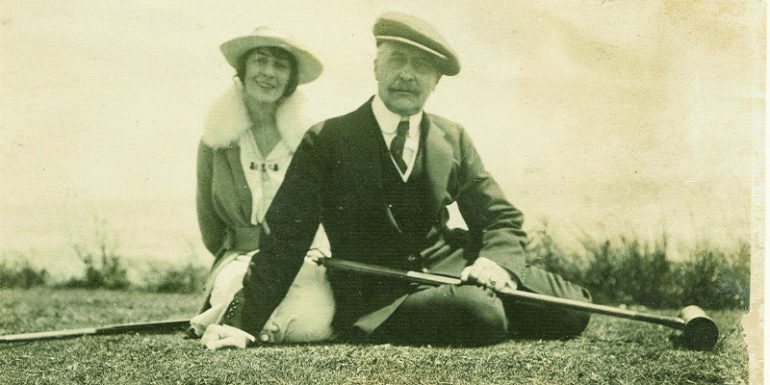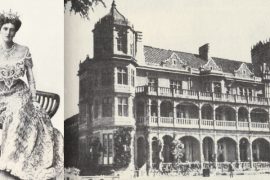By Lisa Schmelz
Harry Gordon Selfridge — who transformed the shopping experience during his rapid rise at Marshall Field & Company in Chicago and later at his eponymous store in England — is the subject of the PBS Masterpiece Classic series: “Mr. Selfridge.” Wisconsin-born, he once had a palatial estate on Geneva Lake.
If you do not know who Harry Gordon Selfridge is, you aren’t alone. Until PBS aired the British television adaptation of Lindy Woodhead’s book, “Shopping, Seduction, and Mr. Selfridge” last spring, most people in America had little reason to know the name Selfridge.
But Simon Wheaton-Smith, a British-born retired FAA crash investigator in Phoenix, knows exactly who Selfridge is.
“I’m the great-grandson of Harry Gordon Selfridge,” he explains by phone. “He had five children, one died shortly after birth. His eldest child was Rosalie and she only had one child, and that was my mother.When I was little, I would sit on [Harry Selfridge’s] knee and he would bounce me up and down.”
Wheaton-Smith isn’t bothered by those Americans who hear his great-grandfather’s name and ask, “Harry who?” Despite his great-grandfather’s enormous contributions to the retail world, where he started as a stock boy and quickly became a major stockholder; despite the fact that he made a fortune helping Chicago’s Marshall Field & Company make millions; despite his revolutionizing retail with bargain basements and famous slogans, Wheaton-Smith acknowledges that Selfridge the man never became a lasting household name in America.
“I would not have expected [Selfridge] to be a household name in the U.S.,” he says, pointing out that Selfridge eventually became a British citizen and was knighted by the monarchy. “In England, his name lives on as the eccentric who built the store, which everyone has heard of. People otherwise do not recall his name specifically, probably because he was removed from the store and died in obscurity.”
That Harry Gordon Selfridge — once dubbed the Earl of Oxford Street and whose store served royalty — would die in obscurity is hard to believe. At one time, Selfridge’s worth was estimated at $40 million. But when he died in 1947, reports indicate he left behind just $6,176.
Flush with millions from his 25-year career with Marshall Field & Company and other lucrative enterprises, and backed by investors with even deeper pockets, Selfridge arrived in England around 1906. His intent?Turn the British retail establishment on its reserved head by opening his own upscale department store. He would eventually send for his family, uprooting them from their Chicago mansion and beloved Lake Geneva estate to a rented castle.
On March 15, 1909, Selfridge’s Department Store opened on Oxford Street in London. Staid British merchants may not have welcomed or respected him, but shoppers loved him. They loved stepping into a store where shopping wasn’t a sterile and rigid exchange of cash for goods, but a true experience. At Selfridge’s, “just looking” wasn’t a commercial sin but an expected journey. Selfridge is credited with creating the slogan “The customer is always right,” and “Business as Usual,” (the latter during World War I). And or ‘thrifty housewives,’ Selfridge added a Bargain Basement in 1911.
But as spectacularly as Harry Gordon Selfridge succeeded, he also failed. While he certainly encouraged his shoppers to “just look,” he seemed incapable of that restraint himself. In 1939, after refusing to pay back a mountain of debt, the prolific (and likely addicted) spender, gambler, and womanizer, was forced out of the store that bore his name.
The store still stands today, a monument to a retail genius. But the apostrophe that once graced its moniker, that notable piece of punctuation that signifies possession, left not long after he did.
Selfridge spent his remaining eight years living with his daughter, Rosalie, in a humble apartment in England. Remarkably, Wheaton-Smith says family legend never recalls his grandfather’s final years as angry or bitter.
“He became somewhat, my word for it would be, senile,doddering,” says Wheaton-Smith. “His clothes became somewhat tattered. He would go up to the store and just walk past it. It was all really sad, and he was actually arrested for vagrancy once and I would have loved to see the officer’s face when he found out who he was.”
THE EARL OF OXFORD STREET IS BORN — IN RIPON, WISCONSIN
Sources vary, but sometime between 1856 and 1858, Harry Gordon Selfridge was born in Ripon, a frontier town that had only been founded less than a decade earlier, to Robert Oliver and Lois Frances (Baxter) Selfridge. Robert and Lois lived in a humble home on the corner of Watson and Steward Streets. In the mid-1850s, Robert owned a general store on the west side of Ripon’s public square and was active in civic life. By 1859, he appears to have sold the general store business and was listed in a town directory as a contractor.
There was no silver spoon waiting for Harry Selfridge or his two brothers, Charles and Robert. In 1861, Robert Selfridge, Sr., left to fight in the Civil War as an adjutant on General Pope’s staff and later for General Granger. Records show he survived, but never returned to his family. He died in 1873.
After his death, Lois and Harry, her only surviving son, moved to Jackson, Michigan, where she found work as a teacher.
By 1879, Harry was in Chicago working as a stock boy for what would become known as Marshall Field & Company. Six years later, he was a major stockholder of the same company. According to Bill Bryson’s Made in America, Selfridge was a true retail pioneer. Selfridge experimented with the concept of using counters and tables to display retail goods, instead of high shelves. He also thought to place perfumes and cosmetics near the ground floor entrance to mask the horse odors coming in from the street and allow sweet fragrances to waft outside as a lure. Selfridge is also credited with creating gift certificates and scheduling annual sales.
In 1890, he married Chicago socialite Rosalie Buckingham, whose upbringing could not have been more different from his own.
Born in Chicago in 1860 to Benjamin Hale Buckingham and Martha Euretta Potwin, Rosalie Selfridge’s life was privileged from the start. Her grandfather, Alvah Buckingham, co-founded the firm Buckingham and Sturges,which built the Windy City’s first grain elevator and scored a lucrative grain warehousing contract with the Illinois Central Railway.
Educated and fluent in many languages, Rosalie was more than well-heeled. In many ways, she was a woman ahead of her time. A successful property developer in her own right before her marriage, she owned coveted stretches of downtown Chicago. She was 30 years old when she married Selfridge, older than many first-time brides of the era.
After they married, the couple maintained a primary residence in Chicago and went on to have four surviving children: Rosalie, born in 1893; Violette, in 1897; Gordon, in 1900; and Beatrice, in 1901. A first child, Chandler, was born in Lake Geneva in 1891, but died shortly after birth and is buried in Oak Hill Cemetery. Nearly all of their married life, Selfridge’s mother, Lois, would reside with the family as well.
HARROSE HALL
In 1899, following the lead of Rose Selfridge’s sister Anna and her husband, Chicago real estate baron Frank R. Chandler — who had recently reconstructed the elaborate Ceylon Court on their property in Lake Geneva — the Selfridges built Harrose Hall on their adjoining Lake Geneva property. The name was a combination of their first names — Harry and Rose.
Designed by the esteemed architect Henry Lord Gay, the Tudor-style home featured a first floor built of native field stone, and brown-timbered upper floors. Gay designed the house with a steel framework, making it possibly one of the first “fireproof” homes built on the lake. The gabled roof was covered with hand-molded green tiles. Setting off those tiles were ornamental copper figures whose purpose was to both adorn and keep away evil spirits. The four-story house contained over 30 rooms, including a massive central hall with a grand double staircase, and third-floor ballroom.
Not long after it was completed, Selfridge hosted a massive gala for Marshall Field employees, from stock boys and errand girls to top management. In 1901, they added a large greenhouse to raise Rose’s prized orchids and roses.
Lawrence Whiting III of Elkhorn can still close his eyes and wander the massive rooms. His grandfather, Lawrence Whiting, Sr., a Chicago banker, bought the estate sometime around 1928, renaming it Somerset. Whiting spent many of his summers there until the house was razed in 1975.
“Probably the most unique feature of the house was the living room,” recalls Whiting. “It had a Tiffany dome, unsigned, as a skylight.”
When Whiting’s grandfather acquired it, he demolished one section of the house, but even with that renovation, the house contained at least 32 rooms, Whiting remembers.
“When Harry and Rose [Selfridge] had it,” he explains, “it was one-third larger, and I’m going by what I was told. At its peak, Harrose Hall was said to include over 17 acres and 350 feet of shoreline.”
At the lakefront, a small grassy peninsula jutted into the water, creating a small bay that was known as Rosalie Bay. A miniature Grecian ‘love temple’ stood at its point. The children were reported to visit a century-old maple tree on the property, dubbing it the “wishing tree” and whispering wishes beneath its shade.
When the Selfridges moved to England, they still spent many summers at Harrose Hall. No doubt the appeal for Rose was her estate’s proximity to her sister’s lakefront residence; a private road connected the two homes.
After moving to England, Rose Selfridge opened the couple’s rented Highcliffe Castle grounds to convalescing WWI American veterans. She died in England in 1918 during the Spanish Flu pandemic. Selfridge’s mother, Lois, passed away in 1924.
Fading Into Obscurity
The loss of his wife and then his mother had a powerful effect on Harry Selfridge. He succumbed to his self-destructive behaviors and began a descent into obscurity. In 1932, he was reported to owe his own company nearly $700,000, just over $11 million in today’s market, and about half that amount in taxes. His relationship with the infamous Dolly Sisters, a Hungarian-American dance duo also said to be gambling addicts, hastened his financial downfall. In just a decade, biographer Bill Bryson reported that Selfridge went through an astounding $8 million, $106 million in today’s economy. It wasn’t his money to spend, says Wheaton-Smith.
“He was spending his stockholder’s money as if it were his own,” he says, “and the one who turned him in was Gordon, his son.”
After refusing to pay back his debts, Selfridge was forced out of the store and spent his remaining years with his daughter Rosalie in a rented apartment. On May 8, 1947, he died in his sleep.
The man born in frontier Wisconsin, who once summered on the shores of Geneva Lake, forever changed the way we shopped. Now, more than six decades after dying in obscurity, his life and genius is once again fascinating a new generation through the magic of television.





